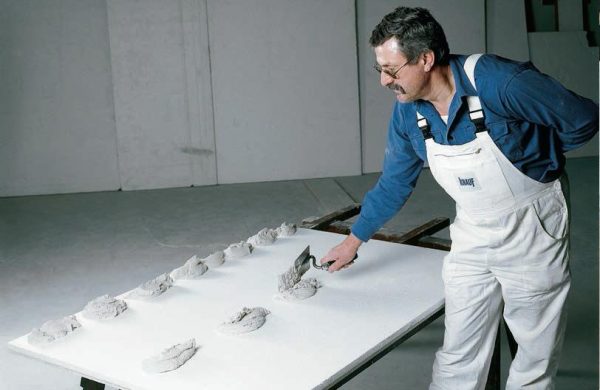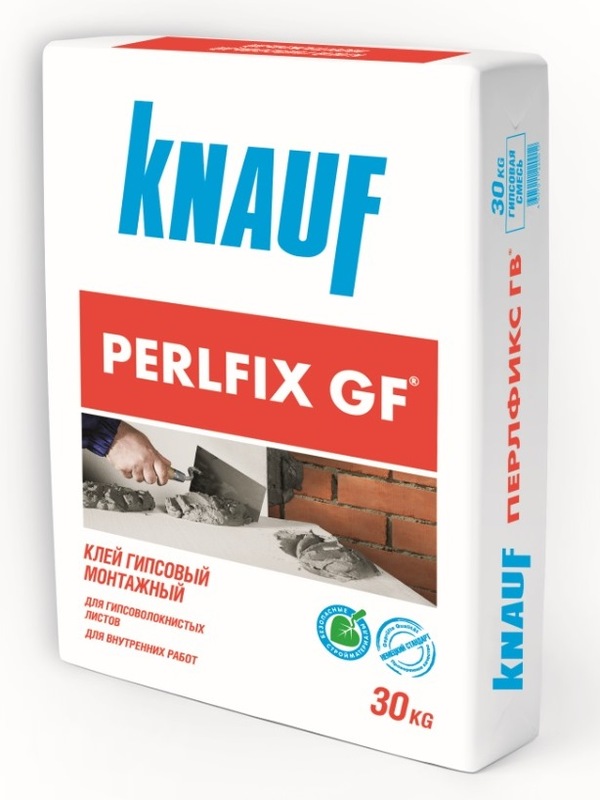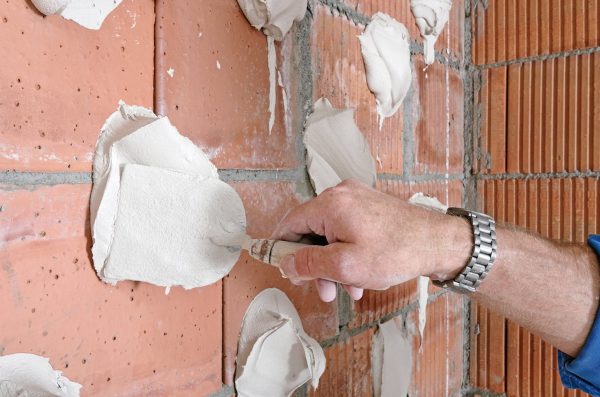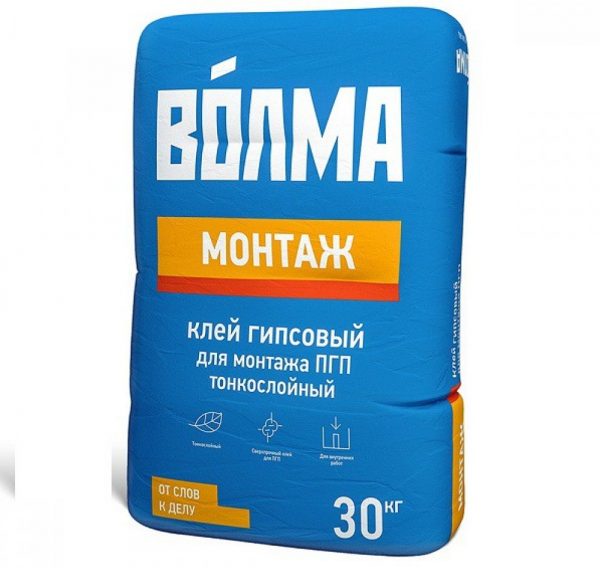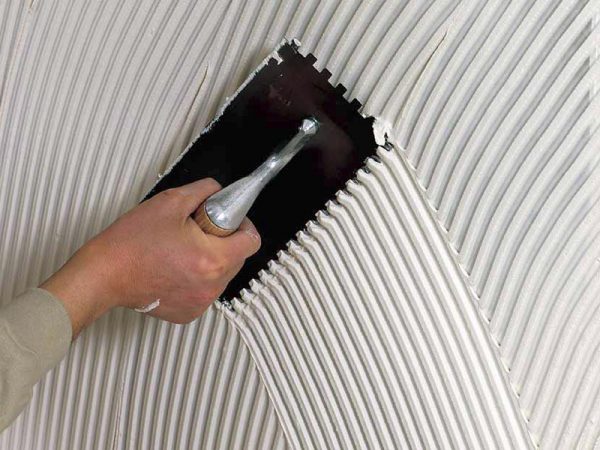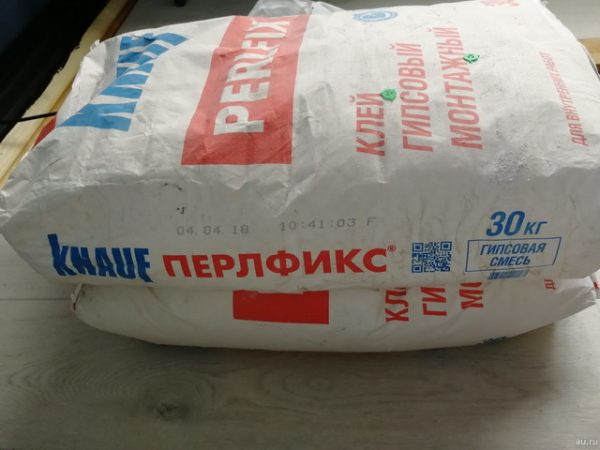The Knauf company is a recognized leader in the production of various construction mixtures and other construction and repair products. One of the brand's most popular products is Knauf Perlfix glue. This composition has high adhesive abilities and is ideal for drywall and a number of other materials.
- Features and applications of glue
- Types and forms of release
- Glue composition
- Properties and characteristics
- Terms of use
- How to calculate the expense
- How to glue drywall on Perlfix - instructions
- Storage conditions
- Glue analogs
- Professional Tips
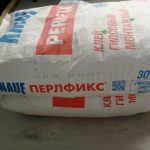
Features and applications of glue
Perlfix mounting adhesive is a gypsum-based dry mix including polymer additives that increase adhesion to various substrates. This bulk mixture is intended directly for use with drywall (GKL), but is also suitable for facing vertical surfaces with such building materials:
- Styrofoam;
- mineral wool;
- gypsum panels and blocks with a matte surface;
- polystyrene foam;
- tongue-and-groove plates;
- insulating materials.
The composition provides a reliable fixation of finishing materials even without the use of additional fastening, and the manufacturer guarantees the absence of damage for several decades. The tool is very convenient to use: you just need to dilute it with water and apply it manually on the cladding sheets. The paste-like mass does not flow, does not slip, is ideally evenly distributed on the treated surface. The basis can be concrete, brick, various blocks.
to contents ↑There is a limitation in the use of Perlfix glue: it cannot be used in rooms with a high level of humidity. Application is allowed only at normal and slightly increased humidity, but subject to the exclusion of direct water. In the process, it is also important to pay attention to the quality of the preparation of walls and finishing material. They must be completely dry, otherwise the reliability of gluing will decrease.
Types and forms of release
On sale you can find two types of glue: standard and with the inclusion of gypsum fiber - Perlfix and Perlfiks GV, respectively. Both products are suitable only for indoor use; their use outside buildings or in high humidity is unacceptable. Glues differ in the level of adhesion to drywall - at Perlfix GV it is slightly better, although both agents can be used on all of the materials listed above. When buying, you should check the certificate of conformity so as not to purchase a fake.
Glues are packed in durable paper bags with internal protection of 15 kg and 30 kg. If the packaging is damaged, it will be necessary to pour the dry building mixture into dense packages to completely exclude moisture - otherwise the gypsum in the composition may become damp and deteriorate.
to contents ↑Glue composition
The basis that provides reliable fastening of drywall is gypsum - a mineral substance from the class of sulfates, environmentally friendly and completely safe to use. Due to the mineral base, the bulk mixture can have white, grayish and even pink colors, and in different batches of material the shade can slightly change. The color of the mixture does not affect its technical characteristics and consumption per 1 m2. In addition to gypsum, the composition includes polymer additives, which act as additional binders, which reduce the GCR porosity and reinforce the surface.
to contents ↑Properties and characteristics
It is not necessary to add other components to dry glue, except ordinary water, it does not require the introduction of hardeners, solvents. The finished solution has a slight moisture resistance, but it has a number of other positive properties:
- resistance to mechanical damaging factors;
- quick setting - in half an hour;
- the possibility of application for puttying, sealing joints between sheets of gypsum plaster;
- enhanced adhesion due to the introduction of special additives;
- long shelf life under the right conditions;
- the possibility of use in unheated buildings;
- environmental friendliness of the composition.
Perlfix glue has a moderate cost - 350-380 rubles for a large package, which is also its advantage and can reduce the total cost of repairs. You can work with the product at temperatures of + 5 ... + 30 degrees, but it shows the best results at + 22 ... + 25 ° С. With a decrease in temperature of less than +5 degrees, often there is a detachment of glue from the finishing materials and walls.
The solution will have to be diluted in small portions - its viability is small (only 30 minutes). To fix the drywall was reliable, the layer should be sufficient - about 2 cm. The time for complete curing of the composition and the start of operation must be sustained, it is 7 days. Only after its expiration can we give a full load to the treated surfaces. After the same period, grouting is allowed. The minuses include the short time to adjust the position of finishing materials - up to 5-10 minutes, which may not be suitable for beginners.
to contents ↑Terms of use
All recommendations for the use of glue are indicated by the manufacturer on the packaging. The instructions are simple and clear, the exact proportions for diluting the mixture are also indicated there.
How to calculate the expense
It is better to make all calculations in advance in order to acquire the required amount of glue. The approximate consumption per 1 m2 is 5 kg of the finished mixture, as indicated by the manufacturer. It can be slightly higher or lower depending on specific conditions, for example, on the quality of the surface, the degree of its unevenness, as well as on the experience of the master.
How to glue drywall on Perlfix - instructions
First you need to prepare the foundation. Dust, particles of an old covering, other pollution are removed from a wall or other surface. Since drywall is a porous material, it must be primed or primed before use. It is advisable to apply a primer in 2 layers.
Next, you need to properly dilute the glue. A package of 30 kg takes 15 liters of water (proportion: 2: 1). It is mandatory to add powder to water, but not vice versa, otherwise the lumps of the mixture will be impossible to break. A precisely measured amount of water at room temperature is poured into a large container, then glue is poured in portions, mixed with a construction mixer or a drill with a suitable nozzle.
It is important that all tools and utensils, as well as water, are clean, otherwise the quality of the finished product will decrease. If the solution is too dense, it can be diluted a little more with water until a thick sour cream is obtained. Beat the solution until the lumps completely disappear, so that the mass becomes homogeneous.
The thickness of the adhesive layer is about 2 cm. The solution is applied not by a continuous, but by a point method - in sections every 2-4 cm, in rows in a checkerboard pattern. If the GCR sheet is thin (less than a centimeter), glue can be applied along the midline and along the edges, as well as diagonally.Thicker sheets require staggered application, but with their small size, 2 rows of adhesive spots are sufficient. Large sheets of drywall of large thickness are treated with glue, also come with a wall, then the material is immediately fixed in place. After applying GCR, you need to align the sheet, applying the level and strictly observing the possible correction time.
to contents ↑
Storage conditions
Shelf life, during which the manufacturer guarantees high quality glue - 6 months. It should be stored in a dry room, despite the presence of several levels of protection in the package. The need to eliminate high humidity is associated with the presence of gypsum in Perlfix. During storage, it is best to put a pack of glue on a wooden pallet, this will help to avoid wetting the mixture.
to contents ↑Glue analogs
There are similar products in stores, which practically do not differ in properties from Knauf Perlfix. The most popular of them:
- ByProc - universal gypsum adhesive GKU-450. It is used for internal work at normal and low humidity. It is used for fastening GKL sheets, heat and sound insulation, mineral wool and polystyrene foam, gypsum fiber. Also, the glue is ideal for gluing stucco, a number of decorative materials and small tiles.
- Volma Montage. This dry mixture provides high adhesion and a long service life, allows you to fix gypsum elements, gypsum board, tongue-and-groove plates, and thermal insulation sheets to the walls. The mixture has a low consumption - up to 2 kg per 1 square. m, as well as the viability of the solution up to 1 hour.
- Perel Gipsel - glue is famous for frost resistance, therefore it can be used in unheated rooms. The time for adjusting the position of plates glued to this tool is only 5 minutes, therefore it will be quite difficult for a beginner to work with it.
- "Founded" - mounting adhesive "Gypsform MG". Used for fixing all types of gypsum fiber and gypsum fiber, as well as expanded polystyrene. It is produced in medium-sized packages - 20 kg each.
Professional Tips
Experts advise to spread glue only in small portions. Given the time the solution is suitable for use, it is difficult to completely consume all packaging diluted with water. Therefore, it is better to divide it into 2-3 parts, carefully put it on a sheet and stick it on the wall, and then go to the next step. Here are other tips from masters for working with Perlfix glue:
- The priming of walls and sheets of gypsum plaster cannot be ignored. Without this, it will not be possible to reduce the porosity of the material, as well as enhance adhesion to the surface. The choice of primer depends on the specific type of finish and base material. After applying the soil, you need to wait until it dries completely, and also make sure that particles of dust and dirt do not stick to the wet wall.
- If you use a thicker solution, it will dry faster, and there will be practically no time for adjustment. But such glue will not come out at the seams of the gypsum board, which will reduce the time for finishing.
- Using cold water to dilute the mortar will slightly increase the pot life of the mortar. Hot water cannot be used for gypsum adhesives!
- When applying glue in a spot, you need to start from the center, continuing towards the periphery. Be sure to walk along the perimeter to securely fasten the sheets and prevent them from moving away from the wall.
- You can not add beginner to solidify unused solution in a freshly diluted mixture. It thickens much faster or may deteriorate altogether. It is also forbidden to add water to the hardening solution - this will seriously reduce its adhesive properties.
Some experts apply glue not pointwise, but with a notched trowel over the entire sheet with a smaller layer thickness (1 cm). In this case, the alignment of GCR on the wall is simpler. Typically, this technique is used in the presence of serious irregularities, cracks, pits on the base. If you follow all the recommendations, you can get excellent quality wall decoration, an excellent level of adhesion, which will extend the operation of the finished coating.

